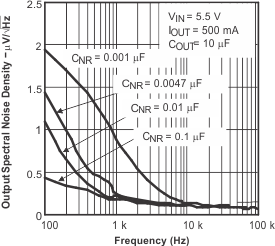JAJS425J October 2002 – May 2019 TPS795
PRODUCTION DATA.
- 1 特長
- 2 アプリケーション
- 3 概要
- 4 改訂履歴
- 5 Pin Configuration and Functions
- 6 Specifications
- 7 Detailed Description
- 8 Application and Implementation
- 9 Power Supply Recommendations
- 10Layout
- 11デバイスおよびドキュメントのサポート
- 12メカニカル、パッケージ、および注文情報
パッケージ・オプション
メカニカル・データ(パッケージ|ピン)
サーマルパッド・メカニカル・データ
- DRB|8
発注情報
6.6 Typical Characteristics
at VEN = VIN, VIN = VOUT(nom) + 1 V, IOUT = 1 mA, COUT = 10 µF, CNR = 0.01 µF, CIN = 2.2 µF, and TJ = 25°C (unless otherwise noted)




















